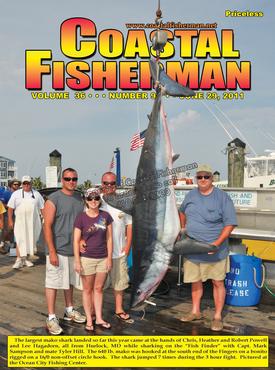


Article by Capt. Mark Sampson
 On the dash of my boat are two slightly used “fish tags.” One came from the back of a mako shark that was originally caught off New Jersey three years prior to us landing it; the other was recovered from a yellowfin tuna that was taken the year before off Massachusetts. Whether or not it’s their original intention when they head out for a day of fishing, any angler might, at any time, become involved in the tagging process. From flounder to blue marlin, there’s a lot of fish swimming around out there that are sporting tags attached to their fins, back, tail or gill, and no one can know if their next cast is going to have them hooked up to one.
On the dash of my boat are two slightly used “fish tags.” One came from the back of a mako shark that was originally caught off New Jersey three years prior to us landing it; the other was recovered from a yellowfin tuna that was taken the year before off Massachusetts. Whether or not it’s their original intention when they head out for a day of fishing, any angler might, at any time, become involved in the tagging process. From flounder to blue marlin, there’s a lot of fish swimming around out there that are sporting tags attached to their fins, back, tail or gill, and no one can know if their next cast is going to have them hooked up to one.
Tags are typically planted either by recreational or commercial fishermen, or in some cases, directly by researchers doing a particular study. Tags come in a variety of designs and can be as simple as a spaghetti-like strip of plastic to an expensive high tech electronic gizmo that automatically uploads its data to a satellite. Some tags are designed specifically for one type of fish such as sharks or billfish, while other tags can be used on multiple species such as flounder, sea bass or stripers. All are printed with a unique tag number and some sort of return address or instructions for fishermen to follow if they recapture the fish.
What a lot of anglers wish to know is, “do I have to release a fish that’s been tagged?” In almost all cases, the answer is “no” as long as the fish is of a legal size and species. The simple fact that it has been previously caught and tagged does not mandate that it be released. Considering that in most cases the reason fish are tagged is so that biologists can track the movements and growth rate of a particular species, it would stand to reason that if a tagged fish was recaptured and then, after recording the tag number, location, and measurements, the angler was to re-release the fish with the tag still in it, that particular fish could provide an extra measure of valuable data to those doing the study, particularly if the fish was ever to be captured a third time. So it would be “better” to release a fish that has a tag in it, but not mandatory.
It’s both fun and quite interesting to catch a tagged fish and learn where and by whom it was originally caught, and each tag recovery provides researchers with a little more knowledge about a particular species. But I think it’s the one who first landed and actually tagged the fish that gets the most sense of accomplishment and really deserves the bragging rights for each tag recovery. When a fish is tagged, the angler’s name and details of the catch will be recorded in the files of the tagging program. Whether it’s a day, a year, or many decades later, if the fish is recaptured, the tagging program that issued the tags usually notifies the angler, congratulating them and providing details about the recapture and in some cases providing a certificate or and award of some sort.
Occasionally, when a fish has traveled a particularly long distance or has been at liberty for an extraordinary length of time between captures, a press release might even be sent out to notify the public that a significant tag recovery has been made.
Face it, most successful anglers like to bring home some kind of evidence of their conquest, particularly after all the time, effort, and resources that so often go into catching a fish in the first place. At times, just turning the fish loose as soon as it’s brought to the boat or shoreline might seem akin to erasing all traces of the effort that was made to catch the fish. But add a tag to the process and suddenly there’s a way for anglers to basically put their “mark” on a fish so that if it’s ever caught again, the original tagger will get credit for being the first one to land it. It’s just a way of saying “I was here”, kind of like carving your name in a tree or adding graffiti to a wall – but in a good way.
Tagging gives fishermen a fun reason to practice careful catch-and-release tactics and a good argument that one of the greatest benefits to a fishery from a tagging program is not so much the science produced, as the conservation efforts made by the fishermen involved with it.
For billfish tags, contact:
The Billfish Foundation
1-800-GET TAGS
www.billfish.org
For shark tags, contact:
Apex Predator Investigation
Cooperative Shark Tagging Program
http://na.nefsc.noaa.gov/sharks/
For sea bass, flounder, striped bass and tautog tags, contact:
American Littoral Society
www.littoralsociety.org
Captain Mark Sampson is an outdoor writer and captain of the charter boat “Fish Finder”, docked at the Ocean City Fishing Center.